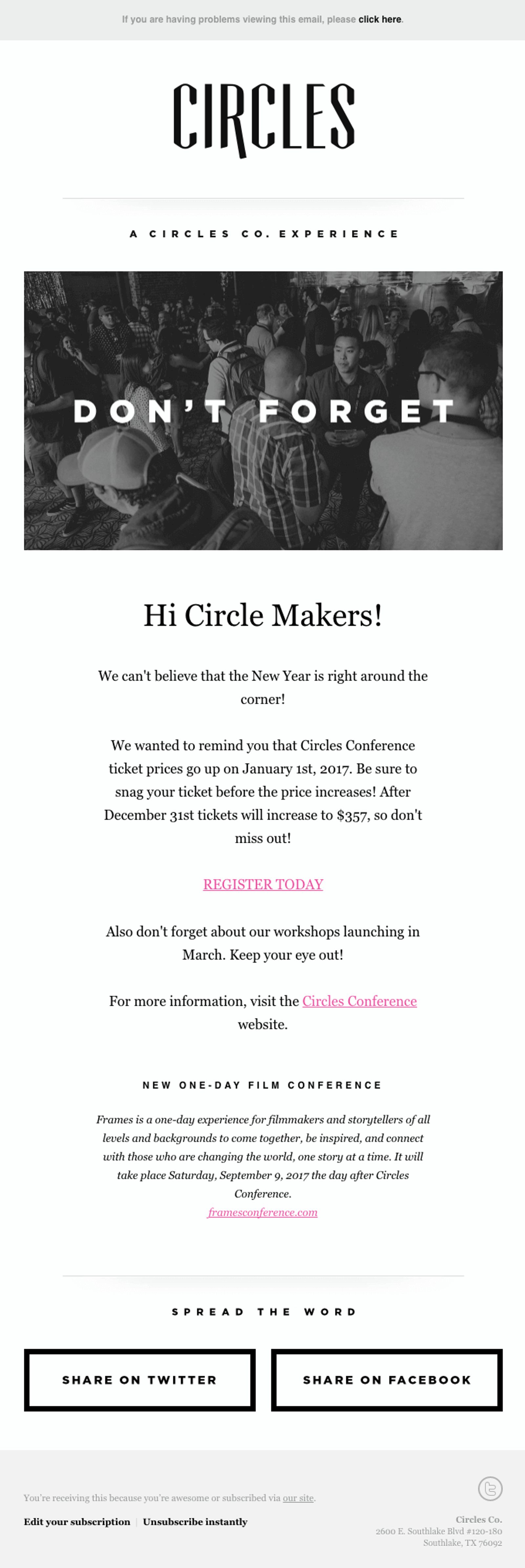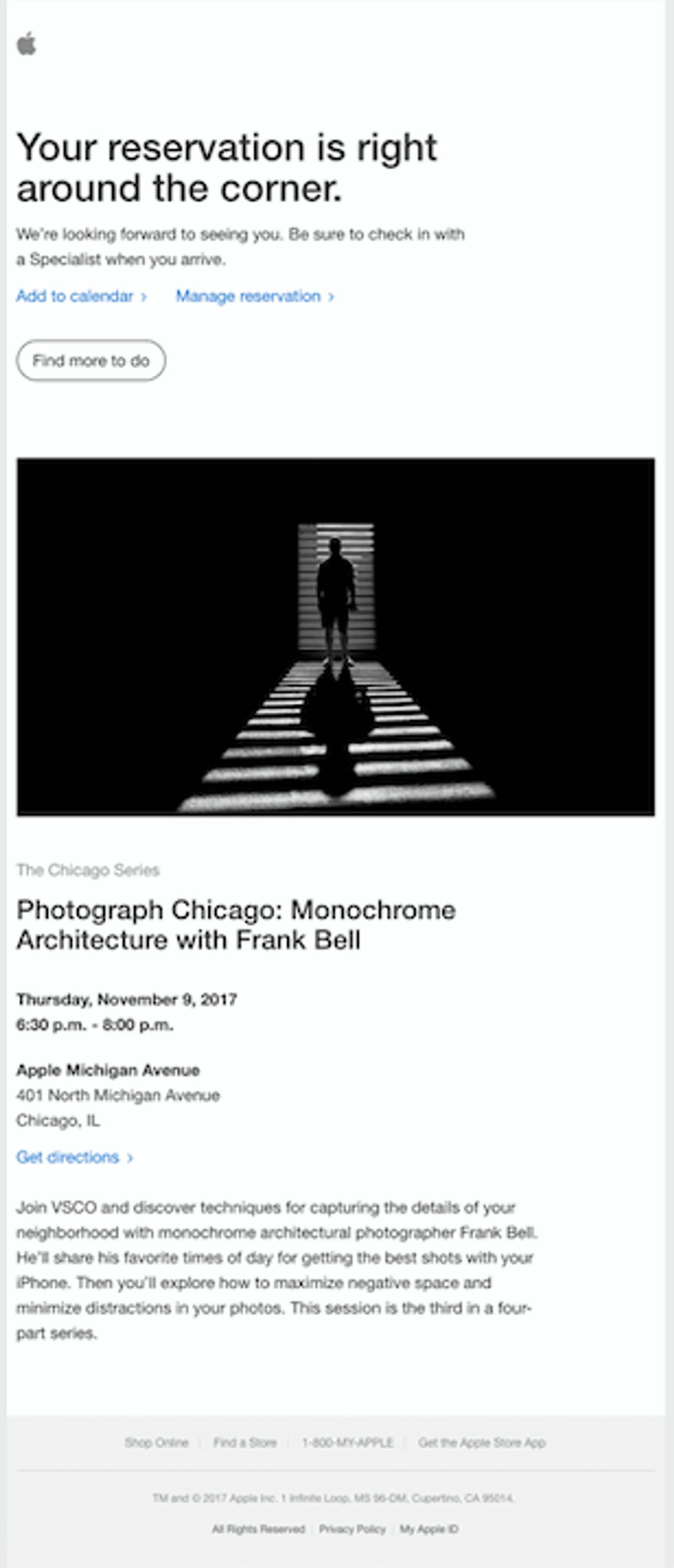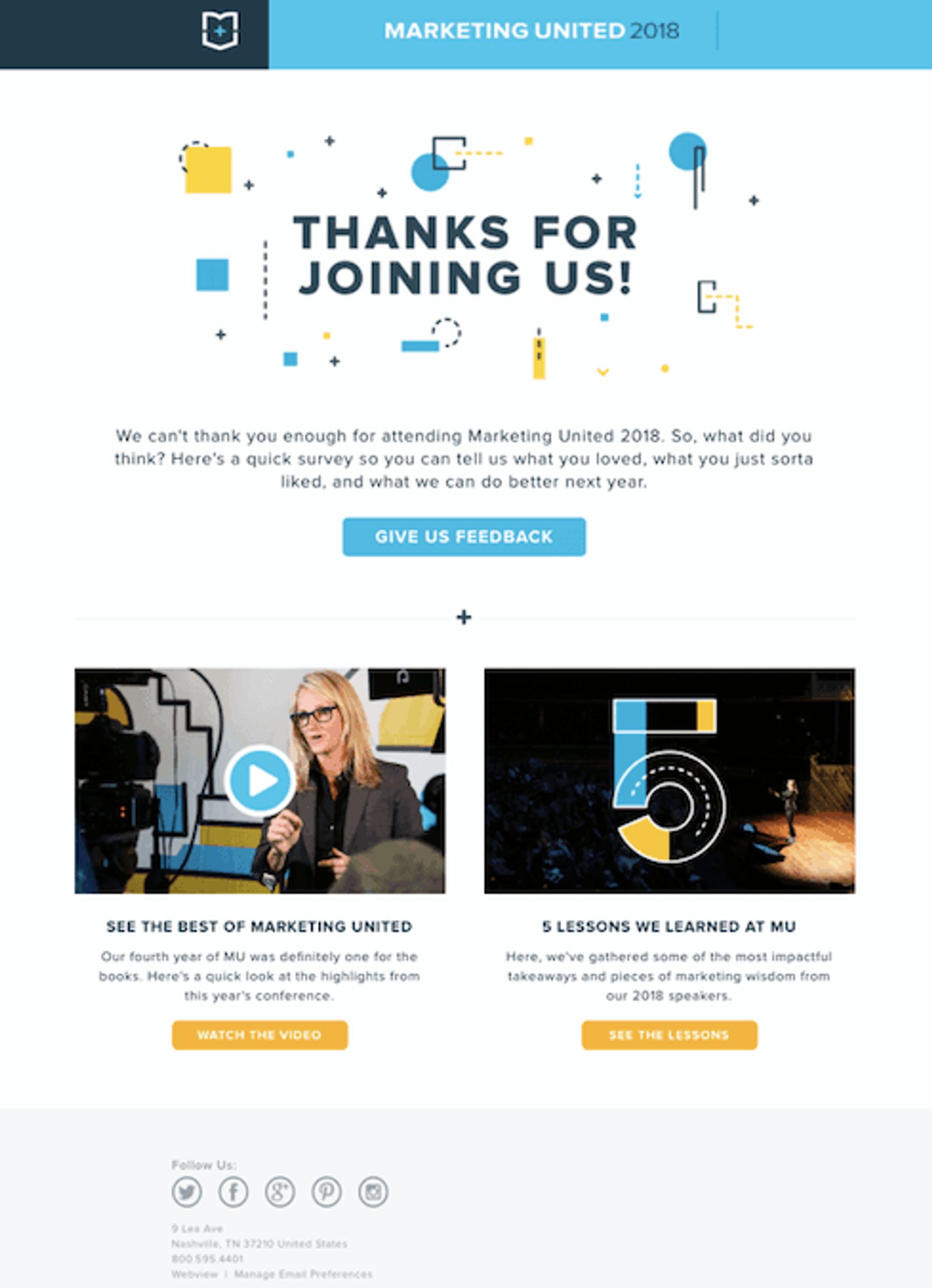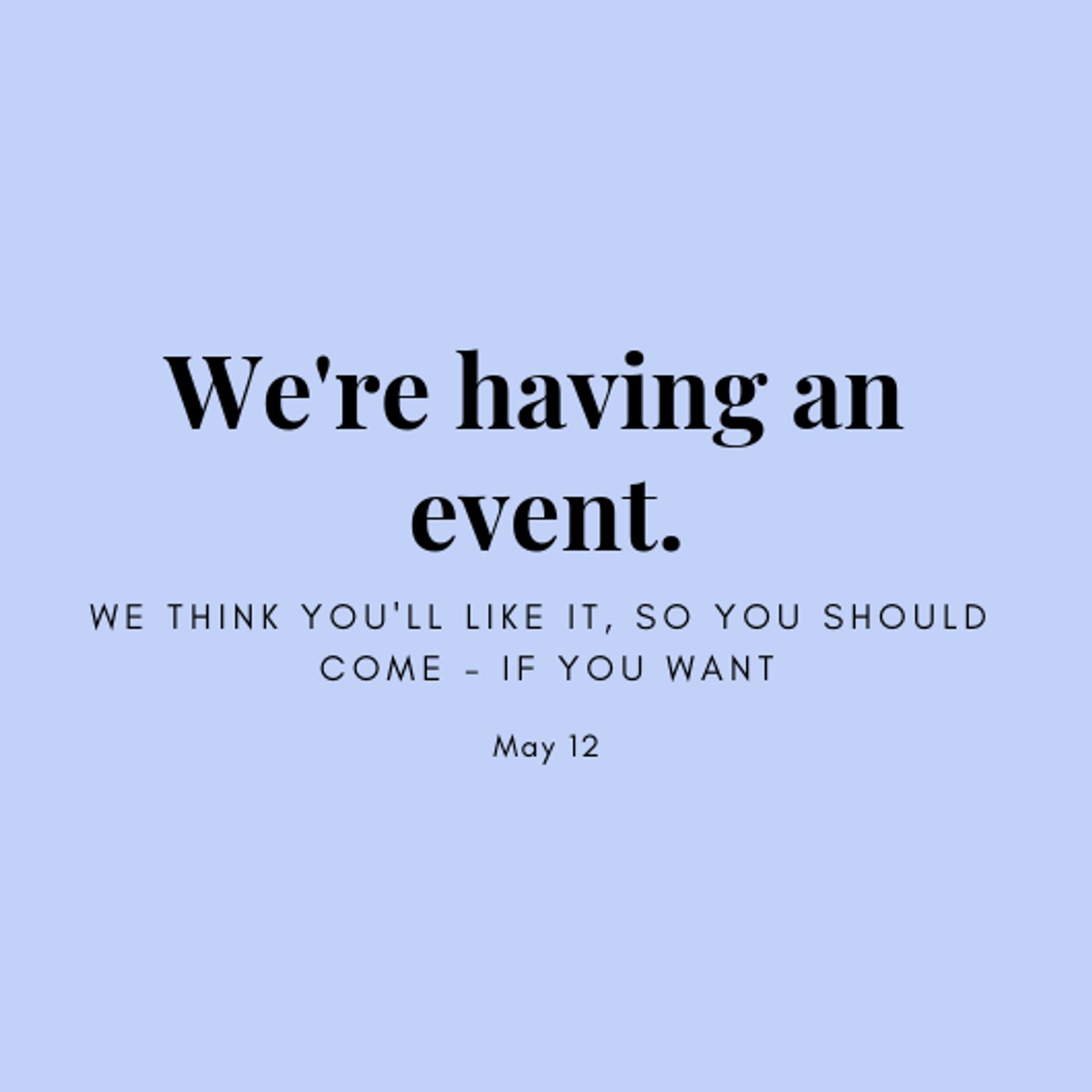“Put me down as a maybe.”
“I have to check my calendar.”
“I don’t know, I’ll let you know.”
Classic responses to an event invitation. Frustrating responses.
Nothing kills the buzz of an exciting event like a lack of attendees.
If you get people to come, hosting events can set your business apart.
- The number of companies organizing 20+ events per year increased by 17% from 2017 to 2018
- 84% of event attendees say they have a more positive opinion about the company after the event.
- 70% of users become regular customers after an experiential marketing event
- 30% of attendees look up future events after they’ve attended a live event
Sounds great! Now you just need to get people to come.
36% of event marketers said that their biggest challenge is increasing event registration.

So, you’re going to need a rocking event email (actually, several).
Here’s what you need to know to get those RSVPs:
- How many event emails should you send? (it’s all about the sequence)
- 6 event email examples that make you stoked to hit ‘Send’ – and people excited to attend.
- Event email tips to boost your attendance – guaranteed
Get ready to see your attendance rate soar.
Try it now, for free
What kind of event emails should you send?
What event emails will get people to show up?
Here are the types of emails to send before and after your event:
- Initial event invitation: Invite your contacts to your event (bonus: ask them to share it)
- RSVP confirmation: Automatically send this to contacts once they confirm their spot. Give them all the details they need to prepare.
- Reminder email to inactive contacts: Remind people who got your original invitation but didn’t respond
- Event info reminder to RSVPs: Remind people the event is coming soon (or follow-up with them afterward).
- Follow-up event email: Thank people for attending! And find out if they liked it. Get testimonials and learn how to improve future events
How frequently you send emails depends on the event you’re having, how many people are invited, and your business as a whole.
Still, here are a couple of ideas that popular event-planning business EventBrite included in their annual Event Email Benchmark Report:
- Tuesdays and Wednesdays are the most popular event email send days in the UK and US respectively
- Among different categories of event emails (like festivals, sports, and classes) the most popular day to send business event emails is on Wednesday.
It’s going to be a lot of emails. The easiest way to avoid spending a ton of time sending emails is automation.
Here’s what event email automation could look like for you.


This automated event email sequence shows an initial event email 1 week away, a reminder 1 day before, and a final email the day of. Each email is triggered by specific dates.
You can use automation to send initial emails. Then keep people in targeted automations if they….
- Ignore emails completely
- Open but don’t click
- Open, click, but don’t RSVP
- Get all the way to RSVP
Automate your event emails and focus on organizing the rest of your event.
If you're looking for more tips on event planning, check out Walls.io's in-depth event professionals toolkit.
6 event email examples that spark a shower of RSVPs
- Initial event email – Use social proof (like Shillington Education)
- Initial event email – Solve a burning problem (like Listrak)
- Initial event email – Make your benefits too good to ignore (like Sumo)
- Non-opener reminder email – Create urgency (like Circle Co.)
- Event info reminder to RSVPs – Use concrete imagery (like Apple)
- Follow-up event email – Make your follow-up interactive (like Marketing United)
1. Use social proof to boost attendance (like Shillington Education)

(Source: Really Good Emails)
In his book Influence: The Psychology of Persuasion, leading psychology professor Robert Cialdini names social proof as one of his 6 core principles of persuasion.
What is social proof? Keep reading.
People decide to do things because other people are doing the same things. Cialdini writes that “we seem to assume that if a lot of people are doing the same thing, they must know something we don’t.”
An event email invitation, like this one from Shillington Education, uses a testimonial from a past attendee to push you in the right direction
- Click the CTA
- Register for the event
Adding a picture to the testimonial makes it more trustworthy.
2. Solve a burning problem (like Listrak)

(Source: Really Good Emails)
“Do you struggle to monetize your Facebook, Instagram, Twitter, YouTube or Google advertising efforts?”
“Do you spend too much time managing data files across different platforms?”
Question – Why do people:
- Buy things
- Subscribe to emails
- Read content
- Attend events
Answer – they want to fix their problems.
This webinar invitation email asks questions to pinpoint customer problems. Then, in detail, it shows how the event will solve them. Just make sure you're using one of our free webinar templates for maximuim impact.
(Bonus: You get to see the instructors who are going to help you, which adds credibility)
3. Make your benefits too good to ignore (like Sumo)

“Want a 50% boost in your eCommerce revenue?”
Who would say ‘No’ to that much money?
This Sumo email headline and copy give an obvious value proposition: two strategies to get you to a 50% boost in revenue. What you get from the event is crystal clear.
Why is this copy so impactful? Numbers. They grab attention and add credibility.
4. Create urgency to convince non-openers (like Circles Co.)

People love to save money and hate to miss out on opportunities to save money. Warning of a price increase might just be enough to light a fire under people who didn’t take advantage of the first invitation email.
The psychology behind this is called the loss aversion. People want to avoid losing things (and you can use that).
If you make your customer feel like they are going to lose something by not acting, that’s loss aversion. When you dangle the idea of an offer slipping away, people are more likely to act in a hurry. In this case, what you can’t afford to lose is the lower ticket price.
5. Talk to people, not at people (like Apple)

I’m going to call out two specific words in this email. Can you guess what they are?
You and your. Here’s why those words matter.
“You” is the most powerful word in the English language. People care about themselves the most.
Brian Clarke, the founder of Copyblogger, talks about the power of “you” in this post. The word “you” makes your writing personal. It puts the focus where it should be (on the customer). Like he said, ultimately you care about yourself most.
6. Make your follow-up interactive (like Marketing United)

This email hits 3 really important parts of an event follow-up email:
- Thank you
- Feedback request
- Recap
First, you can never go wrong with a thank you. They came to your event, and it’s not easy to get people to do that – thank the ones who do and you’ll probably see some repeat attendees at your next one.
Second, get feedback. If you don’t, how do you know if people liked your event? How will you make it better?
80% of reviews come from follow-up emails asking shoppers to review their purchases.
Finally, the recap. Depending on the kind of event you host (webinar vs. in-person or sit-down vs. networking), people might not be able to take notes.
So remind them. This email does that with a video.
Did you know that video email marketing boosts conversions? Click-through rates increase by 200 to 300 percent.
Real quick! 3 tips to create event email copy that won’t leave people scratching their heads
How would you respond to an event email like this?

It’s a little wordy, don’t you think…?
I don’t know about you, but I’m not going based on that email.
What’s wrong with this event email copy?
(“Everything” doesn’t count as an answer).
How about…
- You don’t know who sent it
- What kind of event is this even?
- It doesn’t tell you how to attend (time, place, where you at?)
- It doesn’t even ask you to come – “if you want” isn’t an invitation
- There are no images or visual content
- You have no idea why attending is worth it. Who do you meet? What do you learn?
Like any other email, you need to make it worth the time to read. A documentary about the color gray is more interesting than this email.
Fear not, your event will have all the attendees you desire – if you follow 3 easy-as-pie tips to make your event email copy great.
- Make it personal
- Crush that subject line
- Give relevant info
A personalized email message increases transaction rates up to six times more than a generic message.
The subject line is your first impression. The goal of the subject line is to make people open the email – and the best way to do that is to make them curious.

Subject line got you feeling stuck? Try our Subject Line Generator tool.
People need to know every detail about going and the reasons why they can’t miss it. Give relevant info that will help them actually attend your event.
Final tips to boost event sign-ups
Congrats! You have everything you need to send an event email.
Or so you thought...
Here are a few final suggestions to give your event email an even better chance to convert.
- Offer an early sign-up discount. 64% of event planners believe early bird discounts to be the best promotional event for an event, according to a report by BizBash and Eventbrite.
- Introduce your speakers. Give short profiles and pictures of who will be involved at your event
- Use testimonials from past attendees. According to the Spiegel Research Center, 95%of shoppers read online reviews before making a purchase.
So, one last thing – am I invited? Just kidding!









